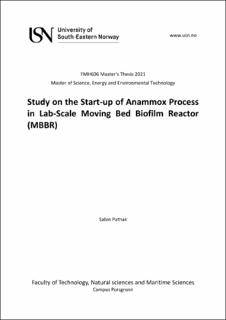| dc.description.abstract | The discharge of wastewater containing nitrogen compounds is harmful to marine life and human health, hence, many biological nitrogen removal methods are in use in many treatment plants in recent years. Among the several alternatives, the deammonification method is considered the best because it is both energy and cost-effective. However, due to the difficulty of suppressing NOB bacteria for partial-nitritation and the slow growth rate of anammox bacteria, implementation is difficult and needs further study. Therefore, this research aimed to gain a better understanding of the partial-nitritation anammox process and to accomplish it without the use of any specific anammox sludge. However, the carriers from KRA`s nitrification-denitrification reactor were used to provide sufficient AOB biofilm.
A moving bed biofilm reactor was set up at USN laboratory for this experiment and was fed with synthetic wastewater. The influent ammonium concentration was maintained at around 140 mg/L, and the alkalinity concentration was adjusted to compensate for the hydrogen ion produced by partial-nitritation. The temperature was maintained around 30οC throughout the whole period, while other operating parameters such as SALR, HRT, and DO were modified over time based on observed data. The transformation of ammonium to other nitrogen compounds by different groups of bacteria was measured by laboratory analysis of nitrogen compounds. In addition, the bacteria growth and its composition in the biofilm were detected by dry weight measurement and the oxygen uptake rate (OUR) test, respectively.
The reactor was operated with different SALR under continuous aeration to achieve partial-nitritation by suppressing NOB. Despite the DO/TAN ratio was low enough and free ammonia levels were above the inhibition range to suppress NOB, the NPR was always higher than NAR. The failure to achieve partial-nitritation was caused by either Nitrospira apps growth or a thin biofilm, but to support this conclusion, additional microbial analysis should be performed. The aeration strategy was therefore changed to intermittent, and two different intermittent aeration cycle was applied i.e., IAC-2 and IAC-4. The close condition of partial-nitritation was achieved with the average value of 35%, 49%, and 74% of NPR, ARE, and NAR, respectively when the IAC-2 was stabilized at IAC-3. Another intermittent aeration cycle (IAC-4) results in a slight decrement in ARE and NPR, while maintaining the same NAR as in IAC-2.
The OUR test shows that the washout of NOB bacteria from the carrier is time-consuming, and most of the time was utilized to remove it. This led to the long and slow start-up of the anammox process. However, implementation of shorter length in the aerobic phase of intermittent aeration cycle and seeding of sludge from anaerobic digestor or denitrifying basin after completion of partial nitritation may result in quick and successful start-up of anammox process. | |
